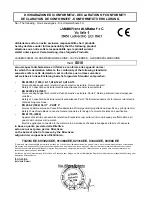
90 / 92 EN
Washing Machine / User‘s Manual
PRODUCT FICHE
Complying Commission Delegated Regulation (EU) No 1061/201
Supplier name or trademark
GRUNDIG
GRUNDIG
Model name
GWN 47230
GWN 47430
Rated capacity (kg)
7
7
Energy efficiency class
(1)
A+++
A+++
Annual Energy Consumption (kWh)
(2)
171
171
Energy consumption of the standard 60°C cotton programme at full load (kWh)
0.798
0.798
Energy consumption of the standard 60°C cotton programme at partial load
(kWh)
0.730
0.730
Energy consumption of the standard 40°C cotton programme at partial load
(kWh)
0.730
0.730
Power consumption in ‘off-mode’ (W)
0.440
0.440
Power consumption in ‘left-on mode’ (W)
0.64
0.64
Annual Water Consumption (l)
(3)
9020
9020
Spin-drying efficiency class
(4)
B
B
Maximum spin speed (rpm)
1200
1400
Remaining moisture Content (%)
53
53
Standard cotton programme
(5)
Cotton Eco 60°C and 40°C
Programme time of the standard 60°C cotton programme at full load (min)
205
205
Programme time of the standard 60°C cotton programme at partial load (min)
177
177
Programme time of the standard 40°C cotton programme at partial load (min)
177
177
Duration of the left-on mode (min)
N/A
N/A
Airborne acoustical noise emissions washing/spinning (dB)
56/74
56/76
Built-in
No
No
(1)
Scale from A+++ (Highest Efficiency) to D (Lowest Efficiency)
(2)
Energy Consumption based on 220 standard washing cycles for cotton programmes at 60°C and 40°C at full and partial load, and
the consumption of the low-power modes. Actual energy consumption will depend on how the appliance is used.
(3)
Water consumption based on 220 standard washing cycles for cotton programmes at 60°C and 40°C at full and partial load. Actual
water consumption will depend on how the appliance is used.
(4)
Scale from A (Highest Efficiency) to G (Lowest Efficiency)
(5)
„Standard 60°C cotton programme“ and the „standard 40°C cotton programme“ are the standard washing programmes to which
the information in the label and the fiche relates and these programmes are suitable to clean normally soiled cotton laundry and that
they are the most efficient programmes in terms of combined energy and water consumption.



































